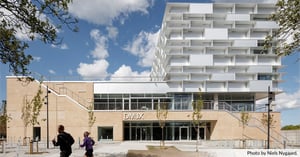Students at the Danish School of Media and Journalism test the ability of itslearning blogs and peer assessment to promote reflection.
The Danish School of Media and Journalism (DMJX) uses the pedagogical approach Reflective Practice-based Learning. Reflection promotes deeper learning, but it’s hard for students to carry out, so we educators are constantly looking for better ways to enable students to reflect.
Reflection is not only a difficult subject to learn, it’s challenging to teach as well. It’s my responsibility to introduce the subject to new students in my department, so I constantly evaluate how to best accommodate this strategy.
One of the challenges is that DMJX has relied to a large extent on students being able to raise their own levels of reflection. But unfortunately, they rarely do.
In the spring of 2021, I was invited to participate in a ‘learning circle’ along with colleagues from our Journalism department. It was then that I decided to take on a project to develop a new method for working with reflection, using itslearning blogs. The support of the learning circle was crucial to this project. They helped decide what questions to ask, challenged me and provided constructive feedback along the way.
Deeper student reflection using peer feedback
At the beginning of the semester, I gave new students a short presentation on Reflective Practice-based Learning and asked them to create a personal blog using the ePortfolio in itslearning. Research shows that the use of a personal blog contributes to deeper learning by reminding students that they they are actually learning something and evolving over the course of a subject and a semester (Lund 2008).
The inclusion of peer feedback also contributes to increased learning. On one hand, the student who is going to receive feedback feels motivated to work more thoroughly with the material because they know a fellow student will see it. On the other hand, the giver of feedback achieves a deeper sense of learning, because giving feedback requires both an understanding of the goal of the assignment and the academic level of the material (Jacobsen & Bahrenscheer 2017).
At the beginning of the course, I asked my students to reflect on and answer five questions in their itslearning blogs. After each week of teaching, students were asked to update their blogs by reflecting on questions related to the prior week.
“We set aside a quarter of class time for reflection, and I can conclude that it has been well spent. Many students said that reflection helped solidify their learning.”
Helle Tougaard, DMJX
At the end of the course, students were asked to summarize their reflections. Most responses were overwhelmingly positive:
- “I’m surprised how much I’ve have learned from reflecting.”
- “It’s been nice to activate one’s own consciousness and reflect on one’s own learning process.”
- “It was great, while writing the final assignment, to look back on the blog and review its development.”
Takeaways on teaching reflection
As mentioned, research suggests that peer feedback increases student motivation, and those giving feedback benefit as well. So in the future when I work with Reflective Practice-based Learning, I will continue to use itslearning blogs, focusing on the role of feedback to determine if this method leads to deeper learning.
This article is part of a wider project which aims to increase the reflection skills of students at the Danish School of Media and Journalism. It is a cooperation between assistant professor Mette Stentoft and associate professor Lars Bjerg from the Journalist department, and associate professor Helle Tougaard Andersen and assistant professor Michael Bækgaard from the Department of Communication Studies.
Read the original article here.
